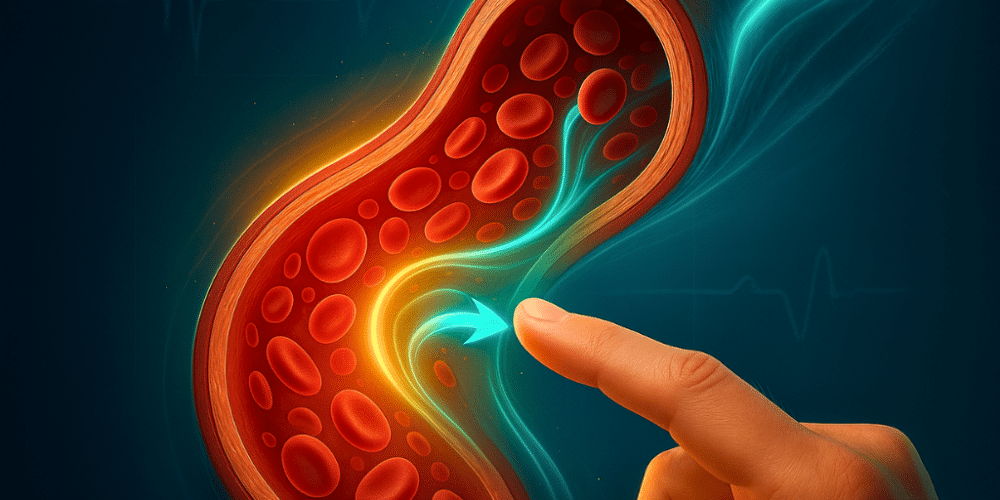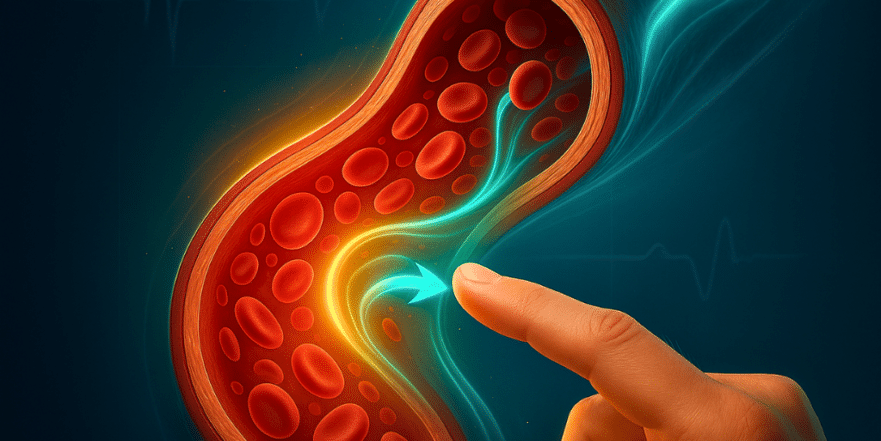
Did you know that every 40 seconds, someone in the world dies from cardiovascular disease? It’s a shocking statistic, but it’s the reality we face. This isn’t some mysterious, unavoidable fate. It’s often the result of a simple, gradual process happening inside your body right now: your arteries, the vital lifelines that carry oxygen to every single cell, are becoming stiff and clogged. This process, known as atherosclerosis, is the root cause of heart attacks, strokes, and sudden cardiac failure. But what if I told you that one of the most powerful tools to reverse this damage isn’t in a pharmacy, but in your grocery store’s produce aisle?
Think of your arteries as flexible, elastic garden hoses. When they’re healthy, their inner lining, called the endothelium, is smooth and incredibly intelligent. It senses your body’s needs and releases a crucial molecule—a natural gas called nitric oxide—to keep your blood vessels open, relaxed, and responsive. However, factors like chronic stress, a poor diet high in sugar, and environmental toxins cause inflammation in this delicate lining. An inflamed endothelium stops producing enough nitric oxide.
Without it, your arteries lose their flexibility. The smooth muscles surrounding them tighten up, your blood pressure rises, and the delivery of life-giving oxygen to your heart and brain starts to decline. This tightness creates tiny micro-tears in the artery walls, and your body, in an attempt to patch them up, uses cholesterol, calcium, and other substances, forming the dangerous plaques that lead to heart disease. The exciting news is that you can directly support your body’s ability to produce nitric oxide, and food is one of the most effective ways to do it.
Key Takeaways
- Cardiovascular disease, the world’s leading killer, often begins when arteries stiffen and clog due to a lack of a vital molecule called nitric oxide.
- Nitric oxide is a natural gas your body produces to relax and widen blood vessels, which improves blood flow, lowers blood pressure, and reduces strain on your heart.
- You can naturally boost your nitric oxide levels by eating foods rich in the amino acids L-citrulline and L-arginine, which your body uses as raw materials.
- The single best food source of L-citrulline is watermelon. The highest concentration is found in the white part of the rind, which most people throw away.
- You can create a powerful, synergistic effect by combining watermelon with other nitric oxide-boosting foods like pumpkin seeds, beets, leafy greens, pomegranates, and garlic.
1. Understand the “Silent Killer”: How Your Arteries Get Clogged
To truly appreciate the solution, you first need to understand the problem. Atherosclerosis doesn’t happen overnight. It’s a slow, progressive disease that can begin in childhood. The process starts with damage to the endothelium, that thin layer of cells lining your arteries. When this lining is healthy, it’s a smooth, non-stick surface that promotes easy blood flow. But when it becomes inflamed, it turns sticky. Think of it like a pristine Teflon pan that, after years of scratches and high heat, starts to have food stick to it.
This initial damage can be caused by many of the usual suspects of modern life: high blood sugar, high blood pressure, smoking, chronic stress, and a diet filled with processed foods. When the endothelium is inflamed, it can no longer produce enough nitric oxide. This is the critical turning point. Without sufficient nitric oxide to keep them relaxed and flexible, the smooth muscle cells in your artery walls begin to constrict. This constant tightness not only drives up your blood pressure but also creates microscopic injuries. Your body’s emergency response is to send a “patching crew” of cholesterol, calcium, and inflammatory cells to the site of the injury. Over time, these patches build up, layer by layer, to form a hard, waxy substance called plaque. This plaque narrows the arteries, restricting blood flow and making the vessels stiff and brittle. This is atherosclerosis, and it sets the stage for a heart attack or stroke.
2. Meet Your Body’s “Miracle Molecule”: Nitric Oxide
Now for the hero of our story: nitric oxide. This simple molecule is one of the most important signaling molecules in your entire body, acting as a potent vasodilator. That’s a fancy term meaning it relaxes and widens your blood vessels. When your endothelium releases nitric oxide, it signals the smooth muscles in your artery walls to relax. This expansion has profound effects: your blood pressure naturally decreases, your heart doesn’t have to work as hard to pump blood, and the flow of oxygen and nutrients to every organ in your body increases dramatically.
But how does your body make it? One of the primary ways is through a fascinating amino acid pathway. When you consume foods containing an amino acid called L-citrulline, your kidneys convert it into another amino acid, L-arginine. From there, an enzyme uses L-arginine to produce nitric oxide. This nitric oxide then goes to work, preventing platelets from clumping together (a key step in clot formation) and calming inflammation within the vessel walls. In short, nitric oxide is your body’s built-in maintenance system for keeping your arteries clean, calm, and wide open. Studies consistently show that people who eat foods rich in these precursors have better “flow-mediated dilation”—a measure of how well arteries can expand—and lower arterial stiffness, which is one of the strongest predictors of future heart disease.
3. The #1 Nitric Oxide Booster: Watermelon (and Its Secret Part)
So, where can you get the L-citrulline needed to kickstart this whole process? While it’s found in a few foods, one stands head and shoulders above the rest: watermelon. This refreshing summer fruit isn’t just hydrating; it’s nature’s most concentrated source of L-citrulline. Ounce for ounce, no other food on the planet comes close.
But here’s the secret that most people miss. While the sweet, red flesh of the watermelon contains a good amount of L-citrulline, the real treasure is hidden in the part everyone throws away: the white rind. That pale, firm layer between the red fruit and the tough green skin contains the highest concentration of this powerful amino acid. By discarding the rind, you’re literally throwing away the most potent part of the fruit for your cardiovascular health. The best part is that it’s easy to incorporate into your diet. When you’re making a smoothie, simply cut up a few small chunks of the white rind and toss them in with the red flesh. The taste is very mild and will be completely masked by the other ingredients, but your arteries will feel the difference. I guarantee it. You’re giving your body the direct raw material it needs to repair your endothelium and produce the nitric oxide that keeps your cardiovascular system youthful and resilient.
4. Build Your Artery-Clearing Arsenal: More Nitric Oxide Superfoods
While watermelon is the undisputed champion of L-citrulline, you can support your nitric oxide production from multiple angles by including other powerful foods in your diet. Your body has more than one way to make this miracle molecule.
- Pumpkin Seeds and Nuts: Foods like pumpkin seeds, almonds, and walnuts are excellent sources of L-arginine, the amino acid that is the direct precursor to nitric oxide. By eating these, you’re giving your body a more direct building block.
- Beets and Leafy Greens: Vegetables like beets, spinach, and arugula work through a completely different but equally effective pathway. They are rich in natural nitrates. When you eat them, bacteria in your mouth convert these nitrates into nitrites, which are then converted into nitric oxide in your body. This provides a secondary route for boosting your levels.
- Pomegranates: This fruit acts as a protector. Pomegranates are packed with antioxidants that help protect the endothelium from inflammatory damage. More importantly, they help extend the life of the nitric oxide your body has already produced, making it more effective for longer.
- Garlic: Garlic is a fantastic enhancer. It contains compounds that activate the enzyme (nitric oxide synthase) responsible for converting L-arginine into nitric oxide, essentially making your body’s production line more efficient.
5. Create a Powerful Synergy: Combining Foods for Maximum Effect
This is where the magic really happens. You can think of these foods as members of an orchestra, each playing a different but essential part. Eating just one is helpful, but combining them creates a symphony of cardiovascular support. When you eat watermelon and pumpkin seeds, you’re supplying your body with both L-citrulline and L-arginine, the primary fuel for the main nitric oxide pathway. When you add beets and spinach, you’re opening up the secondary nitrate-to-nitrite pathway, creating nitric oxide from a different source. Finally, when you include pomegranate and garlic, you’re protecting the nitric oxide you’ve just made and enhancing the machinery that produces it.
This synergistic approach ensures that you’re not just pushing one button but supporting the entire system. You’re providing the raw materials, activating multiple production lines, and protecting the final product. This is far more effective than relying on a single food or supplement. You’re creating a resilient system that can effectively combat inflammation, lower blood pressure, and restore flexibility to your arteries.
6. Your Daily Nitric Oxide Boosting Plan
Putting this knowledge into practice is simple and delicious. Here is a powerful, artery-cleansing smoothie you can make in the morning or after a workout to flood your system with everything it needs to boost nitric oxide naturally.
The Artery-Boosting Smoothie:
- 2 cups of watermelon chunks
- A few small pieces of the white watermelon rind
- 1 large handful of spinach or arugula
- 1 tablespoon of raw pumpkin seeds
- 1/4 to 1/2 of a small, raw beet
- A splash of water or coconut water to blend
Simply combine all these ingredients in a blender and blend until smooth. Within minutes of drinking this, you are delivering a potent dose of L-citrulline, L-arginine, and natural nitrates into your bloodstream. Your body immediately recognizes these precursors and gets to work. The beauty of this approach is that you are not forcing your body to do anything with harsh drugs or chemicals. You are gently providing the natural compounds it already knows how to use to heal and regulate itself. The result is better circulation, more oxygen reaching your heart and brain, and a noticeable increase in energy and vitality.
Conclusion
Remember, your arteries are living, dynamic tissues. They respond directly to what you feed them. You have an internal pharmacy capable of producing one of the most powerful healing molecules for your heart, and you can activate it with simple, everyday foods. You don’t need exotic supplements or expensive programs. The power to reclaim your cardiovascular health is waiting for you in the produce aisle. So the next time you slice into a juicy watermelon, don’t stop at the red part. Save a piece of that white rind, toss it in your blender, and know that you are fueling your heart, your brain, and your entire body with one of the most potent natural medicines on Earth.
Source: Dr. Mandell

